Module 4 Unit 2 What's he doing? 表格式教案(含反思)
文档属性
| 名称 | Module 4 Unit 2 What's he doing? 表格式教案(含反思) | 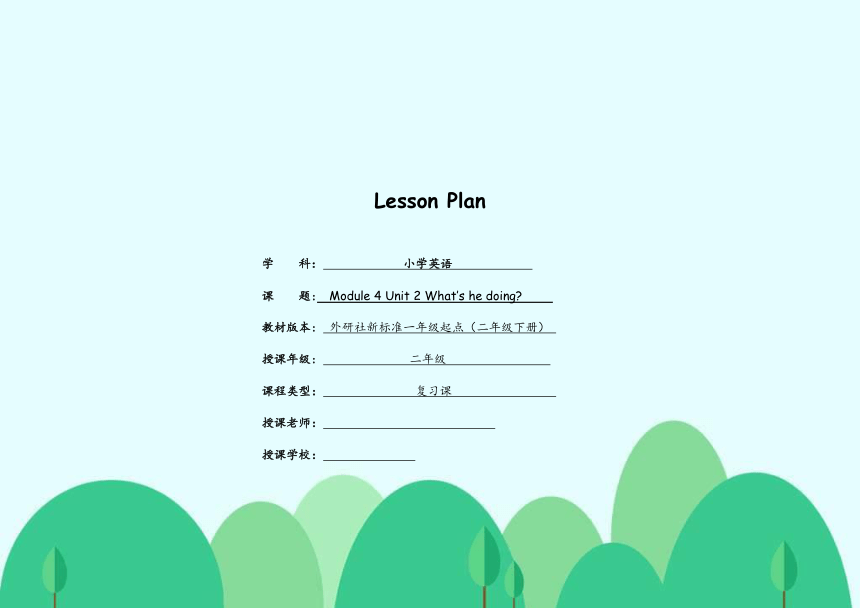 | |
| 格式 | docx | ||
| 文件大小 | 2.6MB | ||
| 资源类型 | 教案 | ||
| 版本资源 | 外研版(一年级起点) | ||
| 科目 | 英语 | ||
| 更新时间 | 2022-03-08 09:39:37 | ||
图片预览

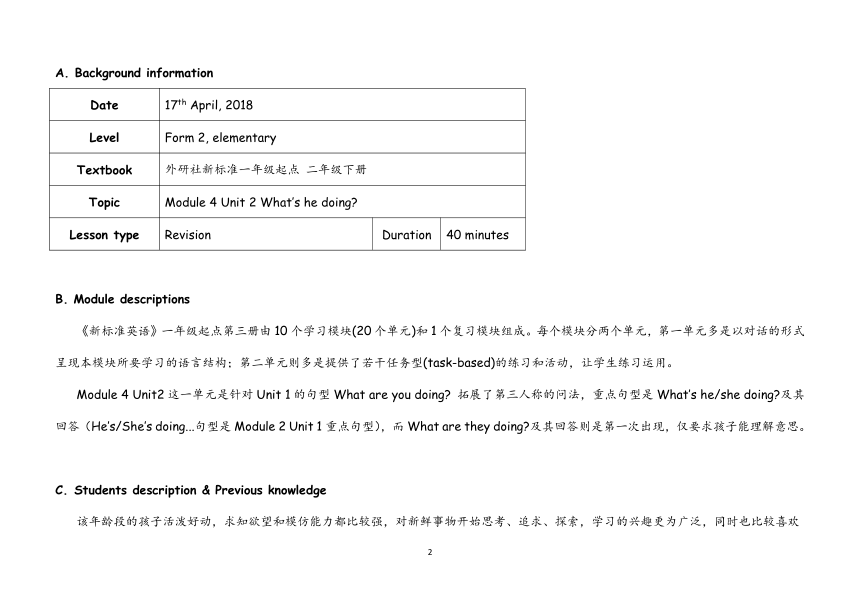
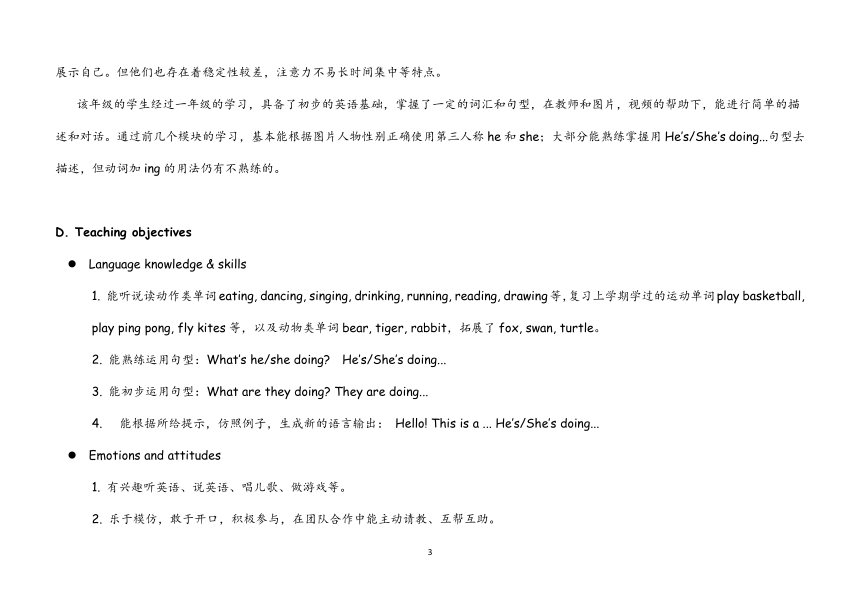
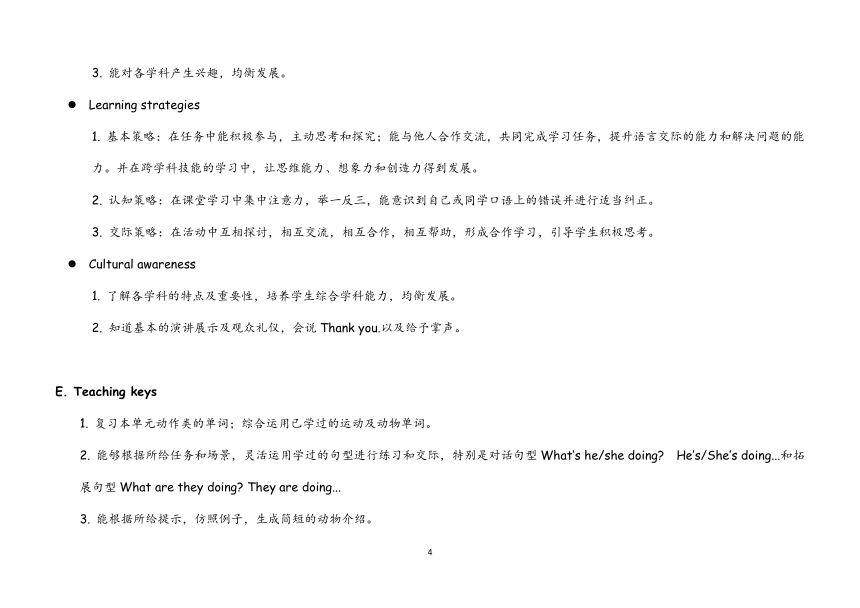
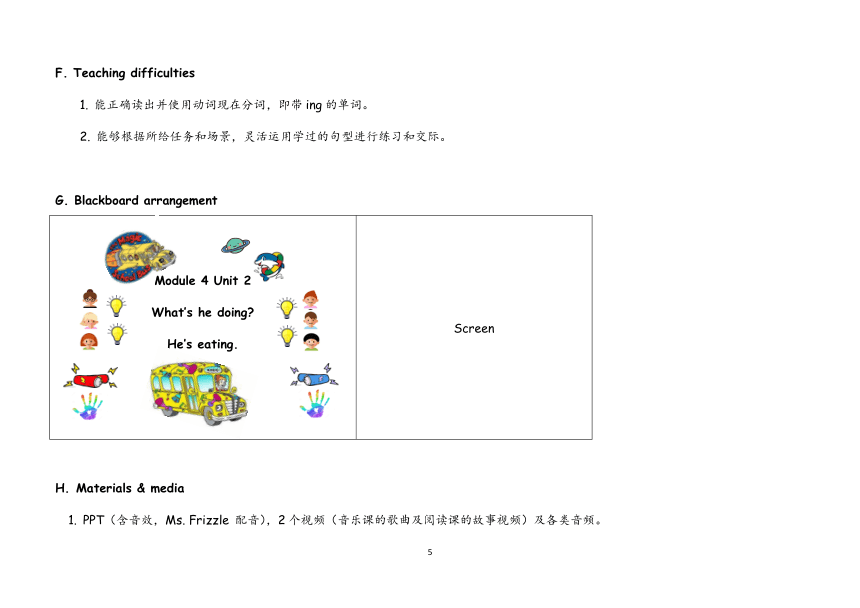
文档简介
Lesson Plan
学 科: 小学英语
课 题: Module 4 Unit 2 What’s he doing
教材版本: 外研社新标准一年级起点(二年级下册)
授课年级: 二年级
课程类型: 复习课
授课老师:
授课学校:
A. Background information
Date 17th April, 2018
Level Form 2, elementary
Textbook 外研社新标准一年级起点 二年级下册
Topic Module 4 Unit 2 What’s he doing
Lesson type Revision Duration 40 minutes
B. Module descriptions
《新标准英语》一年级起点第三册由10个学习模块(20个单元)和1个复习模块组成。每个模块分两个单元,第一单元多是以对话的形式呈现本模块所要学习的语言结构;第二单元则多是提供了若干任务型(task-based)的练习和活动,让学生练习运用。
Module 4 Unit2这一单元是针对Unit 1的句型What are you doing 拓展了第三人称的问法,重点句型是What’s he/she doing 及其回答(He’s/She’s doing...句型是Module 2 Unit 1重点句型),而What are they doing 及其回答则是第一次出现,仅要求孩子能理解意思。
Students description & Previous knowledge
该年龄段的孩子活泼好动,求知欲望和模仿能力都比较强,对新鲜事物开始思考、追求、探索,学习的兴趣更为广泛,同时也比较喜欢展示自己。但他们也存在着稳定性较差,注意力不易长时间集中等特点。
该年级的学生经过一年级的学习,具备了初步的英语基础,掌握了一定的词汇和句型,在教师和图片,视频的帮助下,能进行简单的描述和对话。通过前几个模块的学习,基本能根据图片人物性别正确使用第三人称he和she;大部分能熟练掌握用He’s/She’s doing...句型去描述,但动词加ing的用法仍有不熟练的。
D. Teaching objectives
Language knowledge & skills
能听说读动作类单词eating, dancing, singing, drinking, running, reading, drawing等,复习上学期学过的运动单词play basketball, play ping pong, fly kites等,以及动物类单词bear, tiger, rabbit,拓展了fox, swan, turtle。
能熟练运用句型:What’s he/she doing He’s/She’s doing...
能初步运用句型:What are they doing They are doing...
能根据所给提示,仿照例子,生成新的语言输出: Hello! This is a ... He’s/She’s doing...
Emotions and attitudes
有兴趣听英语、说英语、唱儿歌、做游戏等。
乐于模仿,敢于开口,积极参与,在团队合作中能主动请教、互帮互助。
能对各学科产生兴趣,均衡发展。
Learning strategies
基本策略:在任务中能积极参与,主动思考和探究;能与他人合作交流,共同完成学习任务,提升语言交际的能力和解决问题的能力。并在跨学科技能的学习中,让思维能力、想象力和创造力得到发展。
认知策略:在课堂学习中集中注意力,举一反三,能意识到自己或同学口语上的错误并进行适当纠正。
交际策略:在活动中互相探讨,相互交流,相互合作,相互帮助,形成合作学习,引导学生积极思考。
Cultural awareness
了解各学科的特点及重要性,培养学生综合学科能力,均衡发展。
知道基本的演讲展示及观众礼仪,会说Thank you.以及给予掌声。
E. Teaching keys
1. 复习本单元动作类的单词;综合运用已学过的运动及动物单词。
2. 能够根据所给任务和场景,灵活运用学过的句型进行练习和交际,特别是对话句型What’s he/she doing He’s/She’s doing...和拓展句型What are they doing They are doing...
3. 能根据所给提示,仿照例子,生成简短的动物介绍。
F. Teaching difficulties
1. 能正确读出并使用动词现在分词,即带ing的单词。
2. 能够根据所给任务和场景,灵活运用学过的句型进行练习和交际。
G. Blackboard arrangement
Module 4 Unit 2 What’s he doing He’s eating. Screen
Materials & media
PPT(含音效,Ms. Frizzle 配音),2个视频(音乐课的歌曲及阅读课的故事视频)及各类音频。
四线格及卡通贴纸用语板书。
12张卡纸(对折成小册子)及动物和动作贴纸。
《神奇校车》绘本微课及动画片,用于课前熟悉人物。
Procedure
Stage 1 Lead in (3 minutes)
Steps Activities Sample language Purpose
1 T-SS Greeting. Present our topic “Module 4 Unit2 What’s he doing ” on the screen. T: Good morning, everyone! T: How are you T: I’m happy, thank you. 老师通过和学生们轻松地打招呼,引领学生自然而然地进入英语氛围,舒缓学生的紧张情绪。
2 Introduce Ms. Frizzle. Play an audio of Ms. Frizzle introducing herself and asking students if they like her magic school bus. T: Today we have a new teacher,Ms. Frizzle. She has a big magic school bus. It can take us to anywhere we want. Let’s welcome. 学生观看过《神奇校车》的动画片及绘本微课,对人物及校车熟悉,简单呈现出Ms. Frizzle,更像介绍一个旧朋友,贴近实际情景。
3 T-SS Assign tasks. We need to finish three lessons before we have a field trip with Ms. Frizzle. Play an audio of Ms. Frizzle introducing today’s schedule and asking students to finish three lessons. Then present a picture of students lining up in front of the magic school bus and play the sound of bus horns. T: Do you want to go with Ms. Frizzle T: Look! The bus is waiting. Who can get on the bus first Boys or girls 全程配备Ms. Frizzle的录音,不需要老师假装其他人,情景不虚假。此处设置任务,孩子能需要完成3节课(音乐课,科学课,阅读课)的学习,才能开展神奇校车之旅,可激起学生的兴趣。
4 Get ready for next class. Remind students to rest on the table. T: Get ready for our first class. T: Have a rest. 模拟日常每节课的课前准备,增加真实感。
Stage 2 Music Class (10 minutes)
Steps Activities Sample language Purpose
1 T-SS Music class begins. Monitor gives instruction “ One two three” while the rest respond “ABC” and then they all sit well. Play an audio of Ms. Frizzle welcoming students to the music class. T: Do you like music T: Today I will be Ms. Frizzle’s helper. T: What are we going to do 模拟日常每节课的课堂礼仪,增加真实感。 播放Ms. Frizzle的语音,让孩子进入音乐课的情境中,老师作为辅助提出今天的音乐课要做什么的疑问。
2 T-SS S-SS Look and imitate. Learn the actions: Students read the word and act it out at the same time. Play an audio of Ms. Frizzle asking them to learn the actions. Present pictures with words Little teacher. Demo. Pair practices: Students work in pairs. One read and act (he/she can think of different actions), the other one imitates. Present a list of words for them to choose and practice. Teacher walks around and check their process. Little teacher: Invite students to come to the front and teach others. Remind students to praise whoever comes out to share saying “Good, good, very good!” T: Can you T: Stand up! Ready Go! T: Wow! Adorable! T: I want to be a little teacher. Let me teach you. Follow me. Running! T: Now be a teacher to teach your partners. Okay T: Now start! T: Who can try T: Good, good, very good! T: All of you did a good job! Sit down please. 活动一让孩子集体站起来朗读动作类单词并且看着图片模仿动作。从视觉上、肢体上让孩子复习单词,调动孩子的积极性,并且有助他们记住单词的意思。 活动二利用低年级孩子喜欢展示自我的心里,激发学生争当小老师,创设机会让他们开口说。为降低紧张度及难度,同时让害羞的孩子也有机会练习,选择让他们先在同伴间进行练习。打破传统的老师一人教的模式,又锻炼了学生自主学习的能力。
2 T-SS Listen and guess. Students listen and guess what the character is doing. Play an audio of Ms. Frizzle assigning the task. Play the sound and invite students to guess. Involve more students to answer. T: Now what are we going to do Listen carefully. (Meanwhile pointing one ear.) T: Listen! T: Is she/he right T: What’s your answer 通过各种动作的声音让孩子猜,运用句型去描述,从听觉上刺激,增加趣味性及教学方式的多样性。 邀请数个孩子去回答同一个问题,让更多孩子有发声的机会。
3 Sing and dance. Play an audio of Ms. Frizzle inviting students to show their singing and dancing. T: Who can sing Can you dance T: Let’s see who can sing and dance better. T: Stand up, everyone. 选择了一首节奏感强又容易学的歌曲,调动了学生的听觉、视觉,唱跳同时学习气氛显得轻松活泼。
4 Check who can get on the bus Play an audio of Ms. Frizzle praising their performance. Remind students to rest on the table. T: I think you all did a good job. Let’s see if Ms. Frizzle is happy with you. T: Congratulations! In music class, all of you can get on the bus. T:Are you happy T: Have a rest. 根据孩子实际情况,把评价抛给Ms. Frizzle,效果更真实。
Stage 3 Science Class (10 minutes)
Steps Activities Sample language Purpose
1 T-SS Science class begins. Monitor gives instruction “ One two three” while the rest respond “ABC” and then they all sit well. Play an audio of Ms. Frizzle welcoming students to the science class. T: What are we going to do T: How can we light the bulbs (Meanwhile pointing the bulbs.) 引导学生认识灯泡,帮助他们理解接下来的活动。
2 T-SS Assign tasks: light the bulbs. Guide students to think of solutions lighting bulbs up. Play an audio of Ms. Frizzle leaving the problems “how to light the bulbs”. T: What do we need (Meanwhile pointing the battery on the blackboard.) T: Look! I have the batteries. But you need to have a competition to get it. Let’s see how it works. 像真正的科学课一下让孩子了解基础的关于电的知识。因孩子词汇量的缺乏,使用了图片引导孩子思考。同时这作为游戏的背景导入,增加了游戏的意义。
3 S-SS Game: Get the battery Representatives stand in front and ask the rest “What’s he/she doing ” When they hear “Go!” they need to rush and put his/her hand on the handprint. Each time invite two girls and two boys. Remind students to praise whoever comes out to share saying “Good, good, very good!” T: Two girls and two boys stand here asking questions. And the rest of you need to answer and give order “go”, then they start to catch the battery. Okay T: Who can try 针对孩子爱参与游戏的心理,设置游戏让孩子在玩中运用句型,不再是传统的一问一答,而是更有意义的问答,让句型复习不再枯燥。
4 Check who can get on the bus Play an audio of Ms. Frizzle praising their performance. Remind students to rest on the table. T: Look!Who are the winners T: Congratulations, girls! T: Never mind, boys. Work harder in next class. 如果一方赢,而另一方士气低下,需要鼓励。激励孩子继续再下一节课努力。
Stage 3 Reading Class (15 minutes)
Steps Activities Sample language Purpose
1 T-SS Reading class begins. Monitor gives instruction “ One two three” while the rest respond “ABC” and then they all sit well. Play an audio of Ms. Frizzle welcoming students to the reading class. Play an audio of Ms. Frizzle going to show them a video about animals. T: Do you like reading books T: What are we going to read T: We are going to a zoo. I like elephants. What do you like 帮助孩子快速进入“阅读课”状态。 设置悬念,“我们接下来要阅读什么内容?”
2 T-SS Listen and match. Listen and match Play a video about Mary asking animals “What are you doing ” and animals answer “I’m doing…” Invite one student to finish the exercise using pad Check the answers by Asking individuals to answer questions: What’s the ... doing Checking answers on their own worksheet. T: Let’s see what animals we can see. Take out your worksheets. Listen and match animals and the things they are doing. T: Ready T: What’s the bear doing T: Yes or no T:Is he eating T: Any other answers 该练习的设置主要考察孩子能否正确转换I’m doing…和He’s/She’s doing…。内容是小女孩去动物园询问她见到的动物正在做什么,每个动物回答后,均会有单词跟读的环节,能帮助孩子更好的掌握动词发音。 此处为了训练孩子运用句型而选择一问一答的检查方式。呈现了一位学生用平板答的题,最后呈现所有答案让孩子自行检查自己的答案是否正确,提高孩子的自主学习能力。
3 S-SS Introduce and act. Students choose one animals to introduce and act what he/she is doing using: Hello! This is a _____. He’s ________. Demo Teacher shows a demo to students. Individual sharing Invite students to come in the front sharing and acting. Remind students to praise whoever comes out to share saying “Good, good, very good!” T: Look there are six animals. I like the bear. I want to introduce it to you. Look This is a bear. He’s eating. (Meanwhile act like eating.) T: Who can try T: Good, good, very good. T: What animals do you like Do you like the swan T: Come and tell us about your favourite animals. 低年级孩子喜欢模仿动物,而且有较大的表现欲,此处结合模仿让孩子根据阅读材料,在老师的示范基础上,学习介绍动物,帮助孩子整合语言运用。
4 T-SS S-SS Imagine and share. Students work in groups and use their imagination to finish a poster. They stick the animals and the things these animals are doing on it. Demo Teacher presents her own poster as an example to students and explains. Work in a group Students think and discuss in their groups. Teacher walks around and checks if they need help. Presentation Invite students to come out and present their works. They take turns to introduce. Remind students to praise whoever comes out to share saying “Good, good, very good!” Collect students’ works. T: Look! This is my poster. This is a bear. He’s flying kites. This is a fish. He’s drinking. T: Work in groups to finish your work. T: Who can try T: Good job! T: Good, good, very good. 跨学科的学习方式能充分发挥孩子各方面的智能,一方面培养孩子的想象力和创造力,另一方面也是增加英语语言输出的趣味性、真实性和实用性,孩子是在用英语介绍自己的作品,而不是无意义的句型操练。
5 Check who can get on the bus Play an audio of Ms. Frizzle praising their performance. T: Let’s see if Ms. Frizzle is happy with you. Let’s listen! T: Look, these boys can not get on the bus. I’m sad. Are you happy T: Do you want to have a field trip with them T: Great! 最终让所以的孩子都能“上车”参加神奇校车之旅,不让他们觉得努力没有收获,可以保持其学习的积极性。
Stage 4 Ending (2 minutes)
Steps Activities Sample language Purpose
1 Start the field trip. Present a video. In the video, the magic school bus is coming and Ms. Frizzle invites them to get on the bus and fasten their seat belts. . T: Follow me and fasten the seat belt. (Meanwhile do the actions of fastening.) T: Are you ready T: Let’s go! 使用这种方式结尾呼应了一开始的神奇校车之旅,增加趣味性。
Reflection
本课时是该模块的第四课时,重点是复习What’s he/she doing 以及动作类单词。本节课围绕The magic school bus这一主题创设三节课(音乐课,科学课,阅读课)的情境,采用任务型教学,游戏教学等教学手段,让学生在老师的带领下,通过听音辨识、同学互学、模仿展示、贴图绘画等方式组织教学,符合二年级学生喜欢参与和表现特点。
一、激发兴趣
创设三节课的情境初衷在于其更贴近真实,能激发兴趣。音乐课、科学课、阅读课都是孩子熟悉的;低年级孩子不易长时间专注与课堂,本节课的“课”与“课”之间有“课间休息”时间,可给孩子一个缓和,调节孩子的注意力。同时,通过精美的ppt和节奏感强的歌舞视频,卡懂贴纸板书等直观的图片和音效让孩子有更真实的场景,抓住孩子的好奇心,调动积极性。
二、渐渐深入
整节课基本遵循词句篇的顺序,让孩子从听说读做各方面掌握运用重点。音乐课的活动一,看图读单词并模仿动作,复习动词ing;活动二,听音猜,复习基本句型;活动三,唱歌,引出对话句型的复习。科学课的游戏,巩固对话句型,具有趣味性。阅读课的看视频练习一活动,训练了学生的听力,考察孩子能否正确转换I am doing…至He’s/She’s doing…两种句型;在阅读课的结尾拓展了本单元句型,让孩子将句型用于实际中———介绍动物,活用句型。整节课老师通过让学生做一做。猜一猜,唱一唱,跳一跳,说一说,比一比,画一画,环节充分训练了学生听说读技能。
三、理想与现实的差距
纵观本课时的教学,基本达到预期的教学目标。但是,还有较多需要改进的地方:
本节课上课语速偏快,在个别活动进行前并未能详细、清楚地说明要求,孩子不能马上理解老师要他们做什么。比如在要求他们进行小组活动时,虽然我在说“Teach your friends.”时用手画圈示意他们小组间进行活动,孩子显得有些不知要进行什么。
课堂时间掌控能力有待提高,前半节课节奏较快,而后半节课中个别活动(如评价阅读课练习题)过于冗长,致使最后的小组贴画创作时间较赶,有点为赶时间而忽略了孩子的需求。
课堂用语不够激情,未能很好地调动课堂气氛,让孩子真正快速进入到情境中,鼓励性的语句应该更加简洁且有力。
知识拓展部分可以更完善点,可适量增加一些有难度的词,本届课中出现的知识点基本是孩子学过的,仅仅是让孩子统合运用,个人认为可以多一点扩展,让教学内容更丰富。
对于低年级而言,教学活动设计是否可以平衡好游戏性与交际性?让孩子在游戏中用英语交际,而不是单纯的为了操练句型而游戏。这一点需要更多的学习与反思。
Textbook
Student’s poster
22
学 科: 小学英语
课 题: Module 4 Unit 2 What’s he doing
教材版本: 外研社新标准一年级起点(二年级下册)
授课年级: 二年级
课程类型: 复习课
授课老师:
授课学校:
A. Background information
Date 17th April, 2018
Level Form 2, elementary
Textbook 外研社新标准一年级起点 二年级下册
Topic Module 4 Unit 2 What’s he doing
Lesson type Revision Duration 40 minutes
B. Module descriptions
《新标准英语》一年级起点第三册由10个学习模块(20个单元)和1个复习模块组成。每个模块分两个单元,第一单元多是以对话的形式呈现本模块所要学习的语言结构;第二单元则多是提供了若干任务型(task-based)的练习和活动,让学生练习运用。
Module 4 Unit2这一单元是针对Unit 1的句型What are you doing 拓展了第三人称的问法,重点句型是What’s he/she doing 及其回答(He’s/She’s doing...句型是Module 2 Unit 1重点句型),而What are they doing 及其回答则是第一次出现,仅要求孩子能理解意思。
Students description & Previous knowledge
该年龄段的孩子活泼好动,求知欲望和模仿能力都比较强,对新鲜事物开始思考、追求、探索,学习的兴趣更为广泛,同时也比较喜欢展示自己。但他们也存在着稳定性较差,注意力不易长时间集中等特点。
该年级的学生经过一年级的学习,具备了初步的英语基础,掌握了一定的词汇和句型,在教师和图片,视频的帮助下,能进行简单的描述和对话。通过前几个模块的学习,基本能根据图片人物性别正确使用第三人称he和she;大部分能熟练掌握用He’s/She’s doing...句型去描述,但动词加ing的用法仍有不熟练的。
D. Teaching objectives
Language knowledge & skills
能听说读动作类单词eating, dancing, singing, drinking, running, reading, drawing等,复习上学期学过的运动单词play basketball, play ping pong, fly kites等,以及动物类单词bear, tiger, rabbit,拓展了fox, swan, turtle。
能熟练运用句型:What’s he/she doing He’s/She’s doing...
能初步运用句型:What are they doing They are doing...
能根据所给提示,仿照例子,生成新的语言输出: Hello! This is a ... He’s/She’s doing...
Emotions and attitudes
有兴趣听英语、说英语、唱儿歌、做游戏等。
乐于模仿,敢于开口,积极参与,在团队合作中能主动请教、互帮互助。
能对各学科产生兴趣,均衡发展。
Learning strategies
基本策略:在任务中能积极参与,主动思考和探究;能与他人合作交流,共同完成学习任务,提升语言交际的能力和解决问题的能力。并在跨学科技能的学习中,让思维能力、想象力和创造力得到发展。
认知策略:在课堂学习中集中注意力,举一反三,能意识到自己或同学口语上的错误并进行适当纠正。
交际策略:在活动中互相探讨,相互交流,相互合作,相互帮助,形成合作学习,引导学生积极思考。
Cultural awareness
了解各学科的特点及重要性,培养学生综合学科能力,均衡发展。
知道基本的演讲展示及观众礼仪,会说Thank you.以及给予掌声。
E. Teaching keys
1. 复习本单元动作类的单词;综合运用已学过的运动及动物单词。
2. 能够根据所给任务和场景,灵活运用学过的句型进行练习和交际,特别是对话句型What’s he/she doing He’s/She’s doing...和拓展句型What are they doing They are doing...
3. 能根据所给提示,仿照例子,生成简短的动物介绍。
F. Teaching difficulties
1. 能正确读出并使用动词现在分词,即带ing的单词。
2. 能够根据所给任务和场景,灵活运用学过的句型进行练习和交际。
G. Blackboard arrangement
Module 4 Unit 2 What’s he doing He’s eating. Screen
Materials & media
PPT(含音效,Ms. Frizzle 配音),2个视频(音乐课的歌曲及阅读课的故事视频)及各类音频。
四线格及卡通贴纸用语板书。
12张卡纸(对折成小册子)及动物和动作贴纸。
《神奇校车》绘本微课及动画片,用于课前熟悉人物。
Procedure
Stage 1 Lead in (3 minutes)
Steps Activities Sample language Purpose
1 T-SS Greeting. Present our topic “Module 4 Unit2 What’s he doing ” on the screen. T: Good morning, everyone! T: How are you T: I’m happy, thank you. 老师通过和学生们轻松地打招呼,引领学生自然而然地进入英语氛围,舒缓学生的紧张情绪。
2 Introduce Ms. Frizzle. Play an audio of Ms. Frizzle introducing herself and asking students if they like her magic school bus. T: Today we have a new teacher,Ms. Frizzle. She has a big magic school bus. It can take us to anywhere we want. Let’s welcome. 学生观看过《神奇校车》的动画片及绘本微课,对人物及校车熟悉,简单呈现出Ms. Frizzle,更像介绍一个旧朋友,贴近实际情景。
3 T-SS Assign tasks. We need to finish three lessons before we have a field trip with Ms. Frizzle. Play an audio of Ms. Frizzle introducing today’s schedule and asking students to finish three lessons. Then present a picture of students lining up in front of the magic school bus and play the sound of bus horns. T: Do you want to go with Ms. Frizzle T: Look! The bus is waiting. Who can get on the bus first Boys or girls 全程配备Ms. Frizzle的录音,不需要老师假装其他人,情景不虚假。此处设置任务,孩子能需要完成3节课(音乐课,科学课,阅读课)的学习,才能开展神奇校车之旅,可激起学生的兴趣。
4 Get ready for next class. Remind students to rest on the table. T: Get ready for our first class. T: Have a rest. 模拟日常每节课的课前准备,增加真实感。
Stage 2 Music Class (10 minutes)
Steps Activities Sample language Purpose
1 T-SS Music class begins. Monitor gives instruction “ One two three” while the rest respond “ABC” and then they all sit well. Play an audio of Ms. Frizzle welcoming students to the music class. T: Do you like music T: Today I will be Ms. Frizzle’s helper. T: What are we going to do 模拟日常每节课的课堂礼仪,增加真实感。 播放Ms. Frizzle的语音,让孩子进入音乐课的情境中,老师作为辅助提出今天的音乐课要做什么的疑问。
2 T-SS S-SS Look and imitate. Learn the actions: Students read the word and act it out at the same time. Play an audio of Ms. Frizzle asking them to learn the actions. Present pictures with words Little teacher. Demo. Pair practices: Students work in pairs. One read and act (he/she can think of different actions), the other one imitates. Present a list of words for them to choose and practice. Teacher walks around and check their process. Little teacher: Invite students to come to the front and teach others. Remind students to praise whoever comes out to share saying “Good, good, very good!” T: Can you T: Stand up! Ready Go! T: Wow! Adorable! T: I want to be a little teacher. Let me teach you. Follow me. Running! T: Now be a teacher to teach your partners. Okay T: Now start! T: Who can try T: Good, good, very good! T: All of you did a good job! Sit down please. 活动一让孩子集体站起来朗读动作类单词并且看着图片模仿动作。从视觉上、肢体上让孩子复习单词,调动孩子的积极性,并且有助他们记住单词的意思。 活动二利用低年级孩子喜欢展示自我的心里,激发学生争当小老师,创设机会让他们开口说。为降低紧张度及难度,同时让害羞的孩子也有机会练习,选择让他们先在同伴间进行练习。打破传统的老师一人教的模式,又锻炼了学生自主学习的能力。
2 T-SS Listen and guess. Students listen and guess what the character is doing. Play an audio of Ms. Frizzle assigning the task. Play the sound and invite students to guess. Involve more students to answer. T: Now what are we going to do Listen carefully. (Meanwhile pointing one ear.) T: Listen! T: Is she/he right T: What’s your answer 通过各种动作的声音让孩子猜,运用句型去描述,从听觉上刺激,增加趣味性及教学方式的多样性。 邀请数个孩子去回答同一个问题,让更多孩子有发声的机会。
3 Sing and dance. Play an audio of Ms. Frizzle inviting students to show their singing and dancing. T: Who can sing Can you dance T: Let’s see who can sing and dance better. T: Stand up, everyone. 选择了一首节奏感强又容易学的歌曲,调动了学生的听觉、视觉,唱跳同时学习气氛显得轻松活泼。
4 Check who can get on the bus Play an audio of Ms. Frizzle praising their performance. Remind students to rest on the table. T: I think you all did a good job. Let’s see if Ms. Frizzle is happy with you. T: Congratulations! In music class, all of you can get on the bus. T:Are you happy T: Have a rest. 根据孩子实际情况,把评价抛给Ms. Frizzle,效果更真实。
Stage 3 Science Class (10 minutes)
Steps Activities Sample language Purpose
1 T-SS Science class begins. Monitor gives instruction “ One two three” while the rest respond “ABC” and then they all sit well. Play an audio of Ms. Frizzle welcoming students to the science class. T: What are we going to do T: How can we light the bulbs (Meanwhile pointing the bulbs.) 引导学生认识灯泡,帮助他们理解接下来的活动。
2 T-SS Assign tasks: light the bulbs. Guide students to think of solutions lighting bulbs up. Play an audio of Ms. Frizzle leaving the problems “how to light the bulbs”. T: What do we need (Meanwhile pointing the battery on the blackboard.) T: Look! I have the batteries. But you need to have a competition to get it. Let’s see how it works. 像真正的科学课一下让孩子了解基础的关于电的知识。因孩子词汇量的缺乏,使用了图片引导孩子思考。同时这作为游戏的背景导入,增加了游戏的意义。
3 S-SS Game: Get the battery Representatives stand in front and ask the rest “What’s he/she doing ” When they hear “Go!” they need to rush and put his/her hand on the handprint. Each time invite two girls and two boys. Remind students to praise whoever comes out to share saying “Good, good, very good!” T: Two girls and two boys stand here asking questions. And the rest of you need to answer and give order “go”, then they start to catch the battery. Okay T: Who can try 针对孩子爱参与游戏的心理,设置游戏让孩子在玩中运用句型,不再是传统的一问一答,而是更有意义的问答,让句型复习不再枯燥。
4 Check who can get on the bus Play an audio of Ms. Frizzle praising their performance. Remind students to rest on the table. T: Look!Who are the winners T: Congratulations, girls! T: Never mind, boys. Work harder in next class. 如果一方赢,而另一方士气低下,需要鼓励。激励孩子继续再下一节课努力。
Stage 3 Reading Class (15 minutes)
Steps Activities Sample language Purpose
1 T-SS Reading class begins. Monitor gives instruction “ One two three” while the rest respond “ABC” and then they all sit well. Play an audio of Ms. Frizzle welcoming students to the reading class. Play an audio of Ms. Frizzle going to show them a video about animals. T: Do you like reading books T: What are we going to read T: We are going to a zoo. I like elephants. What do you like 帮助孩子快速进入“阅读课”状态。 设置悬念,“我们接下来要阅读什么内容?”
2 T-SS Listen and match. Listen and match Play a video about Mary asking animals “What are you doing ” and animals answer “I’m doing…” Invite one student to finish the exercise using pad Check the answers by Asking individuals to answer questions: What’s the ... doing Checking answers on their own worksheet. T: Let’s see what animals we can see. Take out your worksheets. Listen and match animals and the things they are doing. T: Ready T: What’s the bear doing T: Yes or no T:Is he eating T: Any other answers 该练习的设置主要考察孩子能否正确转换I’m doing…和He’s/She’s doing…。内容是小女孩去动物园询问她见到的动物正在做什么,每个动物回答后,均会有单词跟读的环节,能帮助孩子更好的掌握动词发音。 此处为了训练孩子运用句型而选择一问一答的检查方式。呈现了一位学生用平板答的题,最后呈现所有答案让孩子自行检查自己的答案是否正确,提高孩子的自主学习能力。
3 S-SS Introduce and act. Students choose one animals to introduce and act what he/she is doing using: Hello! This is a _____. He’s ________. Demo Teacher shows a demo to students. Individual sharing Invite students to come in the front sharing and acting. Remind students to praise whoever comes out to share saying “Good, good, very good!” T: Look there are six animals. I like the bear. I want to introduce it to you. Look This is a bear. He’s eating. (Meanwhile act like eating.) T: Who can try T: Good, good, very good. T: What animals do you like Do you like the swan T: Come and tell us about your favourite animals. 低年级孩子喜欢模仿动物,而且有较大的表现欲,此处结合模仿让孩子根据阅读材料,在老师的示范基础上,学习介绍动物,帮助孩子整合语言运用。
4 T-SS S-SS Imagine and share. Students work in groups and use their imagination to finish a poster. They stick the animals and the things these animals are doing on it. Demo Teacher presents her own poster as an example to students and explains. Work in a group Students think and discuss in their groups. Teacher walks around and checks if they need help. Presentation Invite students to come out and present their works. They take turns to introduce. Remind students to praise whoever comes out to share saying “Good, good, very good!” Collect students’ works. T: Look! This is my poster. This is a bear. He’s flying kites. This is a fish. He’s drinking. T: Work in groups to finish your work. T: Who can try T: Good job! T: Good, good, very good. 跨学科的学习方式能充分发挥孩子各方面的智能,一方面培养孩子的想象力和创造力,另一方面也是增加英语语言输出的趣味性、真实性和实用性,孩子是在用英语介绍自己的作品,而不是无意义的句型操练。
5 Check who can get on the bus Play an audio of Ms. Frizzle praising their performance. T: Let’s see if Ms. Frizzle is happy with you. Let’s listen! T: Look, these boys can not get on the bus. I’m sad. Are you happy T: Do you want to have a field trip with them T: Great! 最终让所以的孩子都能“上车”参加神奇校车之旅,不让他们觉得努力没有收获,可以保持其学习的积极性。
Stage 4 Ending (2 minutes)
Steps Activities Sample language Purpose
1 Start the field trip. Present a video. In the video, the magic school bus is coming and Ms. Frizzle invites them to get on the bus and fasten their seat belts. . T: Follow me and fasten the seat belt. (Meanwhile do the actions of fastening.) T: Are you ready T: Let’s go! 使用这种方式结尾呼应了一开始的神奇校车之旅,增加趣味性。
Reflection
本课时是该模块的第四课时,重点是复习What’s he/she doing 以及动作类单词。本节课围绕The magic school bus这一主题创设三节课(音乐课,科学课,阅读课)的情境,采用任务型教学,游戏教学等教学手段,让学生在老师的带领下,通过听音辨识、同学互学、模仿展示、贴图绘画等方式组织教学,符合二年级学生喜欢参与和表现特点。
一、激发兴趣
创设三节课的情境初衷在于其更贴近真实,能激发兴趣。音乐课、科学课、阅读课都是孩子熟悉的;低年级孩子不易长时间专注与课堂,本节课的“课”与“课”之间有“课间休息”时间,可给孩子一个缓和,调节孩子的注意力。同时,通过精美的ppt和节奏感强的歌舞视频,卡懂贴纸板书等直观的图片和音效让孩子有更真实的场景,抓住孩子的好奇心,调动积极性。
二、渐渐深入
整节课基本遵循词句篇的顺序,让孩子从听说读做各方面掌握运用重点。音乐课的活动一,看图读单词并模仿动作,复习动词ing;活动二,听音猜,复习基本句型;活动三,唱歌,引出对话句型的复习。科学课的游戏,巩固对话句型,具有趣味性。阅读课的看视频练习一活动,训练了学生的听力,考察孩子能否正确转换I am doing…至He’s/She’s doing…两种句型;在阅读课的结尾拓展了本单元句型,让孩子将句型用于实际中———介绍动物,活用句型。整节课老师通过让学生做一做。猜一猜,唱一唱,跳一跳,说一说,比一比,画一画,环节充分训练了学生听说读技能。
三、理想与现实的差距
纵观本课时的教学,基本达到预期的教学目标。但是,还有较多需要改进的地方:
本节课上课语速偏快,在个别活动进行前并未能详细、清楚地说明要求,孩子不能马上理解老师要他们做什么。比如在要求他们进行小组活动时,虽然我在说“Teach your friends.”时用手画圈示意他们小组间进行活动,孩子显得有些不知要进行什么。
课堂时间掌控能力有待提高,前半节课节奏较快,而后半节课中个别活动(如评价阅读课练习题)过于冗长,致使最后的小组贴画创作时间较赶,有点为赶时间而忽略了孩子的需求。
课堂用语不够激情,未能很好地调动课堂气氛,让孩子真正快速进入到情境中,鼓励性的语句应该更加简洁且有力。
知识拓展部分可以更完善点,可适量增加一些有难度的词,本届课中出现的知识点基本是孩子学过的,仅仅是让孩子统合运用,个人认为可以多一点扩展,让教学内容更丰富。
对于低年级而言,教学活动设计是否可以平衡好游戏性与交际性?让孩子在游戏中用英语交际,而不是单纯的为了操练句型而游戏。这一点需要更多的学习与反思。
Textbook
Student’s poster
22
同课章节目录
- Module 1
- Unit 1 What's the weather like ?
- Unit 2 I like swimming.
- Module 2
- Unit 1She's listening to the radio.
- Unit 2 I'm drawing a picture.
- Module 3
- Unit 1 Sam isn't tidying his room.
- Unit 2 Are you doing your homework?
- Module 4
- Unit 1 What are you doing ?
- Unit 2 What's he doing?
- Module 5
- Unit 1 Lingling is skipping.
- Unit 2 What are the kids playing?
- Module 6
- Unit 1 I usually play basketball.
- Unit 2 My grandma usually cooks.
- Module 7
- Unit 1 It's Children's Day today.
- Unit 2 We're having a picnic.
- Module 8
- Unit 1 The train is going up a hill.
- Unit 2 The horse is turning around.
- Module 9
- Unit 1 Turn left!
- Unit 2 Where do you live ?
- Module 10
- Unit 1 It's next to the park.
- Unit 2 He's helping a child.
- Review Module
- Unit 1
- Unit 2
